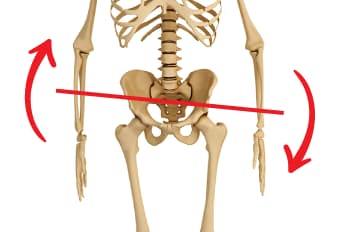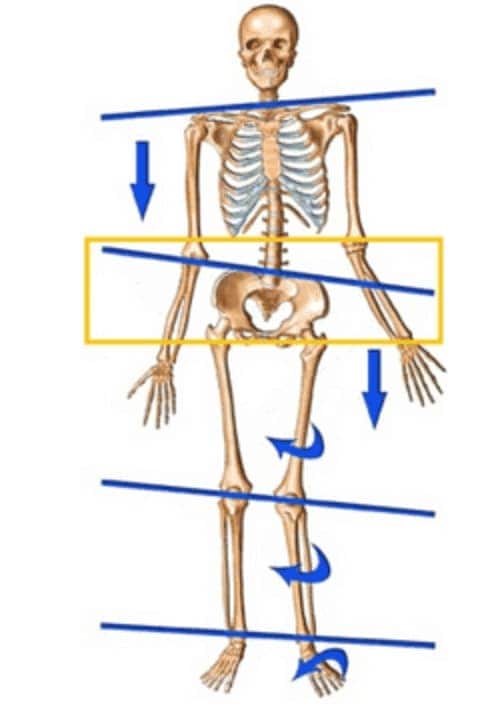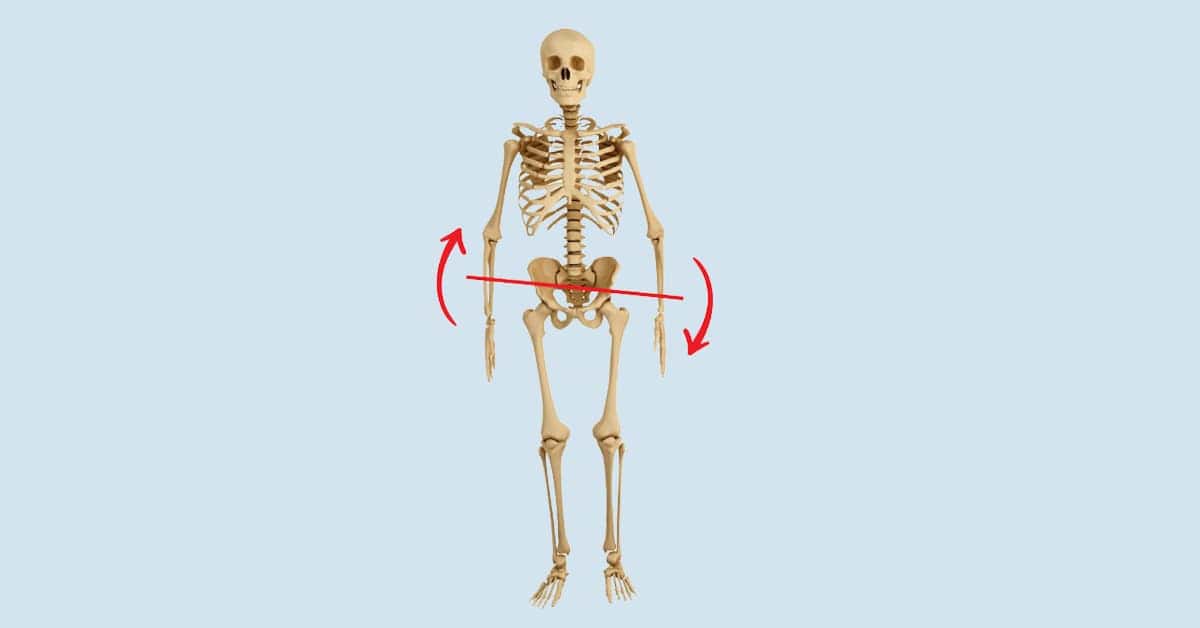Lateral pelvic tilt is a common postural issue that affects many people, particularly those who live sedentary lifestyles or have muscle imbalances. This condition occurs when the pelvis is tilted to one side, causing one hip to be higher than the other.
A lateral pelvic tilt can lead to discomfort, pain, and long-term complications if left untreated. This article will explore the causes, symptoms, and various methods to address and correct a lateral pelvic tilt caused by muscle imbalances and poor posture.
II. What is a lateral pelvic tilt?

A lateral pelvic tilt, also known as pelvic obliquity, is a postural misalignment where one side of the pelvis is higher or lower than the other side. This imbalance can lead to an uneven distribution of weight and force on the spine and lower body, potentially causing discomfort, pain, and long-term issues if left unaddressed [1].
III. Causes of lateral pelvic tilt
A. Structural issues
Although the primary focus of this article is on addressing lateral pelvic tilt caused by muscle imbalances, it’s important to note that structural issues can contribute to this condition. Some structural factors include:
- Leg Length Discrepancy: A difference in leg length, whether due to genetic factors or injury, can cause an uneven distribution of weight on the pelvis, contributing to the development of a lateral pelvic tilt.
- Congenital Deformities Or Injuries: Certain congenital deformities or injuries to the spine or pelvis can result in a lateral pelvic tilt. For example, scoliosis, a condition where the spine has an abnormal curvature, can contribute to developing a lateral pelvic tilt. In such cases, consultation with a medical professional is necessary for proper diagnosis and treatment.
B. Muscle imbalances
Muscle imbalances can result from the body adapting to the positions it’s held in for extended periods. The pelvic bone sits at the top of the thigh bones (femurs) and is supported by a network of muscles that help stabilize the hips and allow for a full range of movement of the legs. These muscles and ligaments include:
- Adductors
- Gluteus medius
- Obliques
- Quadratus lumborum (QL)
- Tensor fascia lata (TFL)
A lateral pelvic tilt may develop when a muscle imbalance occurs between these muscles. Specifically, lateral pelvic tilt results from the tightening and shortening of the adductors, gluteus medius, and quadratus lumborum and the simultaneous weakening and lengthening of the same muscles on the opposite side of the body. This imbalance causes the pelvis to tilt laterally or up to one side, so one hip is higher, hence the term lateral pelvic tilt.
Contributing factors to muscle imbalances include:
- Poor Posture: Holding the body with poor posture, in this case with one hip higher than the other, can lead to muscle imbalances as the body adapts to the positions it maintains for long periods.
- Sedentary Lifestyle: Sedentary lifestyles can contribute to muscle imbalances and tightness that cause lateral pelvic tilt. Extended periods of sitting or standing with poor posture can lead to a tightening of certain muscles and the weakening of others, resulting in an imbalanced pelvis.
- Improper Footwear Or Posture Habits: Wearing shoes with inadequate support, uneven wear, or an improper fit can affect the alignment of the pelvis and contribute to the development of a lateral pelvic tilt. Additionally, poor posture habits, such as consistently crossing one leg over the other, leaning to one side while standing or sitting, or side-sleeping, can exacerbate muscle imbalances and increase the risk of developing a lateral pelvic tilt [2].
IV. Symptoms of lateral pelvic tilt
A. Lower back pain
Lateral pelvic tilt can cause strain and discomfort in the lower back due to the uneven distribution of weight on the spine.
B. Hip pain or discomfort
Muscle imbalances and altered alignment associated with lateral pelvic tilt can lead to hip pain and discomfort.

C. Uneven shoulder height
As the pelvis tilts to one side, the upper body may compensate by leaning in the opposite direction, resulting in uneven shoulder height.
D. Internal rotation of the leg
The muscle imbalances and altered alignment in the pelvis can cause the leg on the lower side to rotate inwards, leading to an internal rotation of the leg.
E. Pronated Foot
A pronated foot, also known as flat feet, can be a symptom of lateral pelvic tilt. This occurs as a result of the internal rotation of the femur and shin bones, which can cause the arch of the foot to collapse and lead to pronation.
It’s important to note that while a pronated foot can be a symptom of lateral pelvic tilt, it can also be a cause. Addressing the issue of pronated feet may be necessary to fully correct a lateral pelvic tilt.
F. Apparent leg length discrepancy
The uneven position of the pelvis can create the appearance of one leg being shorter than the other, even if there is no actual difference in leg length.
G. Difficulty maintaining balance during physical activities
An imbalanced pelvis can affect overall stability and balance, making it challenging to perform physical activities without compensatory movements.
H. Increased risk of injury
Muscle imbalances and compensatory movement patterns associated with lateral pelvic tilt can increase the risk of injury, especially during physical activities.
I. Limited range of motion and restricted flexibility
Lateral pelvic tilt can lead to restricted flexibility and a limited range of motion in the hips, lower back, and legs.
V. Identifying lateral pelvic tilt
A. Self-assessment
To determine if you have a lateral pelvic tilt, perform this simple test: Stand in front of a mirror and place a finger on the bony prominence of each hip bone. Observe whether one finger appears higher than the other. If it does, you may have a lateral pelvic tilt.
B. Professional assessment
If you suspect that you have a lateral pelvic tilt but are unsure, it’s always a good idea to consult with a healthcare professional, such as a physiotherapist, chiropractor, or orthopaedic specialist. These professionals can provide a more accurate assessment of your posture and recommend appropriate treatment options.
VI. How to fix a lateral pelvic tilt
This section will provide a comprehensive approach to correcting a lateral pelvic tilt caused by muscle imbalances. We will begin by addressing tight muscles using release and massage techniques and stretching exercises to lengthen the muscles.
Then, we will focus on strengthening the weak muscles to restore balance. Lastly, we will discuss posture and lifestyle modifications to maintain a healthy alignment and prevent the issue from recurring.
A. Self-massage techniques
Before diving into the stretches and strengthening exercises, it’s essential to address the tight muscles using massage techniques. Releasing tight muscles with targeted massage can help loosen them up and break up knots in these muscles that cause chronic tightness.
Before you perform these release techniques, remember to spend more time on the tighter side, which will typically feel more tender.
1. Adductor release
- Lie face down on a comfortable surface.
- Position a large massage ball under your inner thigh, near the tight adductor muscles (the side with the higher hip).
- Apply gentle pressure, rolling the ball along the inner thigh, pausing at tight spots for 20-30 seconds.
- Increase pressure as the muscles release, and continue for 1-2 minutes.
- Repeat the process on the other leg.
2. Quadratus Lumborum release
- Lie on your back, heels on a chair seat, knees bent at a 90-degree angle.
- Locate the QL muscle on one side of your lower back.
- Position a lacrosse ball under the QL muscle.
- Apply gentle pressure, rolling the ball over the QL muscle area, pausing at tight spots for 20-30 seconds.
- Increase pressure as the muscle releases, and continue for 1-2 minutes.
- Repeat on the other side.
Related: How to stretch and release the Quadratus Lumborem
3. Gluteus medius release
- Sit on the floor, one ankle crossed over the opposite knee in a figure-four shape.
- Place the large massage ball under the glute on the same side as the crossed leg.
- Control movement and pressure with your hands and supporting leg.
- Roll the ball over the gluteus medius, pausing at tight spots for 20-30 seconds.
- Increase pressure as the muscle releases, and continue for 1-2 minutes.
- Switch legs and repeat.
B. Stretching exercises
After releasing the tight muscles, it’s time to focus on stretching them. Remember that paying more attention to the tight side is crucial when performing these stretches.
1. Adductor stretch
- Stand with your feet wider than shoulder-width apart.
- Slightly bend the knee on the side you are not stretching while keeping the other leg straight and out to the side.
- Shift your body weight towards the bent knee side, keeping the opposite leg straight and foot flat on the ground.
- Hold the stretch for 20-30 seconds, and repeat 2-3 times.
Related: How to stretch tight adductors
2. Quadratus lumborum stretch
- Start in a kneeling position with your knees slightly wider than hip-width apart.
- Lower your buttocks toward your heels and stretch your arms out in front of you.
- Walk your hands over to the side opposite the tight QL muscle, reaching as far as comfortable.
- Hold the stretch for 20-30 seconds, and repeat 2-3 times.
3. Gluteus medius stretch
- Lie on your back with both knees bent and feet flat on the floor.
- Cross the ankle of the tight gluteus medius side over the opposite knee, creating a figure-four shape with your legs.
- Grasp the back of the thigh on the non-stretching side with both hands, pulling it gently toward your chest.
- Hold the stretch for 20-30 seconds, and repeat 2-3 times.
C. Strengthening exercises
Finally, strengthening the weak muscles is vital in correcting a lateral pelvic tilt. Concentrate on the weaker side while performing these exercises to build strength and stability in the pelvis.
1. Adductor strengthening
- Lie on your side with the bottom leg straight and the top leg bent, resting the top foot in front of the bottom knee.
- Rest your head on your bottom arm or prop it up on your hand.
- Engage the inner thigh muscles of the bottom leg, lifting it off the ground.
- Slowly lower the leg back down, without letting it touch the ground.
- Perform three sets of 10-15 repetitions on the weak side, gradually increasing as you get stronger.
2. Glute medius strengthening
- Lie on your side with both legs straight and stacked on top of each other.
- Rest your head on your bottom arm or prop it up on your hand.
- Engage the gluteus medius muscles on the top leg, lifting it upwards while keeping your foot parallel to the floor.
- Slowly lower the leg back down, without letting it touch the bottom leg.
- Perform three sets of 10-15 repetitions on the weak side, gradually increasing as you get stronger.
Related: Exercises for glute medius
E. Posture and lifestyle modifications
1. Posture Habits
Improving your daily posture habits can significantly help in correcting lateral pelvic tilt. Consider the following posture adjustments:
- Avoid tilting your pelvis when sitting, for example, sitting on a wallet in your back pocket or with crossed legs, as it can create an uneven distribution of weight and contribute to pelvic imbalances.
- Maintain proper sitting posture by keeping both feet flat on the floor and distributing weight evenly across both hips.
- Use ergonomic chairs and adjust your workstation to promote neutral spine alignment.
- Be mindful of your standing posture, engaging your core and ensuring even weight distribution on both feet.
- Sleep on your back, if possible, to maintain better alignment. If you must sleep on your side, consider switching sides periodically to avoid consistently placing stress on one hip.
2. Regular Movement and Breaks
Sedentary lifestyles can contribute to muscle imbalances and poor posture. Incorporate regular movement and breaks into your day:
- Set a reminder to stand up, stretch, and move around every 30-60 minutes.
- Take short walks during work breaks or consider a standing desk for part of your day.
- Include regular physical activity in your routine, such as walking, swimming, or yoga, to promote overall muscular balance and flexibility.
Final words
Correcting a lateral pelvic tilt requires a comprehensive approach that addresses the underlying causes and contributing factors. By incorporating release techniques, targeted stretching and strengthening exercises, and posture and lifestyle modifications, you can work towards improving your pelvic alignment and overall body function.
Remember to spend more time on the tighter and weaker sides of your body instead of treating both sides equally. This targeted approach will help you address muscle imbalances and work more effectively towards correcting your lateral pelvic tilt.
It’s also important to consider other factors that may be contributing to your lateral pelvic tilt, such as pronated feet. Addressing all aspects of the issue, including any foot misalignment, will increase your chances of achieving the best possible results.
Consistency, patience, and regular monitoring of your progress are essential for success. Don’t hesitate to seek professional guidance if you’re unsure about any aspect of your routine or if you’re not seeing the desired results. By staying committed to your corrective exercises and maintaining proper posture habits, you can gradually improve your lateral pelvic tilt and enjoy a healthier, more balanced body.









